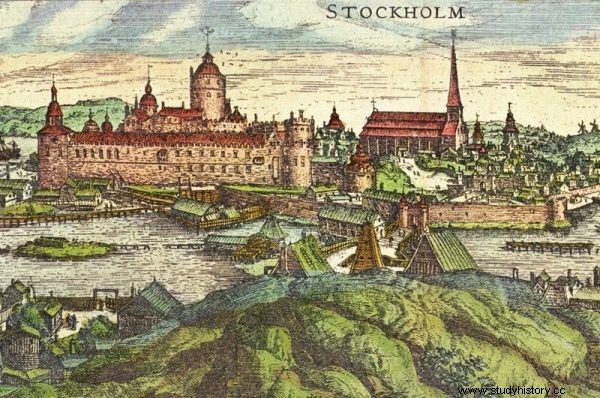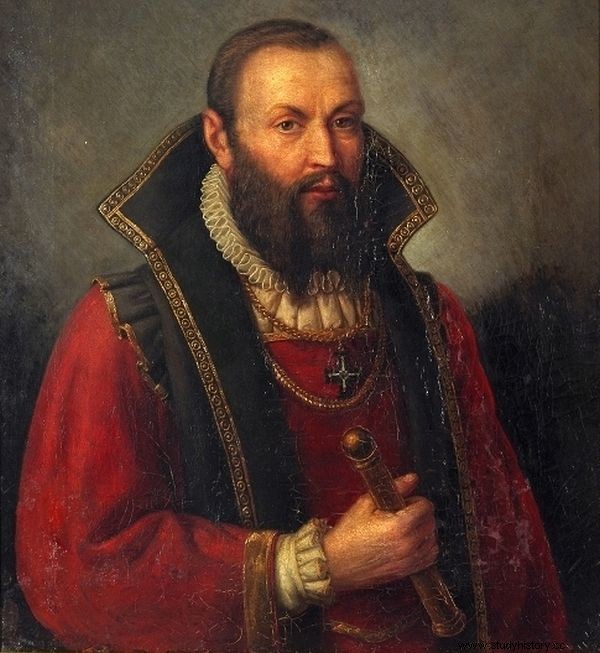There was a time when Berlin was in Poland, Stockholm was conquered by a handful of our own, and Slovakia defended the Polish monarchy. In addition, we had warm Caribbean beaches, power over Moscow and the Germans ... ready to die for Poland. Read for yourself how Europe trembled at the Polish Empire.
1. Polish deluge in Sweden
Sparta had three hundred, we were twelve! A storm threw them on the coast near Stockholm on the night of August 30-31, 1598. They were cold and soaked, but their leader, Samuel Łaski, decided to take the city.
Poles entered the capital of Sweden to the accompaniment of thunder and took the town hall . In the morning they called the patricians to announce the takeover of the city by the king of Poland! This is the only time Stockholm has fallen into non-Scandinavian hands.
Although Sigismund III Vasa had been king of Sweden for six years, the throne was slipping from his hands due to the actions of his ambitious uncle, Charles. So the Poles decided to go overseas.
As Michael Morys-Twarowski writes in the book “Polskie Imperium. All countries conquered by the Republic of Poland ":
Officially, Sigismund was going to put things in order in Sweden, but in practice it was a military expedition financed by the Commonwealth, headed by the Polish king.
Our fleet took Kalmar, and then a storm cut off part of the army ... including a ship with Łaski on board.

Samuel Łaski only needed 12 people to conquer Stockholm (source:public domain).
2. To Kyiv, Moscow and… Nowogród
As early as 1018, Bolesław the Brave seized Kyiv. At that time, the purchase could not be maintained. But five and a half centuries later, Ukraine fell into Polish hands. For a long time. In 1569, the Lithuanians, unable to defend the south, gave Poland Wołyń, Podolia, Bracław and Kiev lands. The incorporation of a partially uninhabited territory meant that the Polish nobility had something to settle.
The success in Ukraine only increased the appetite for expansion. In 1609 a Polish expedition to Moscow started . The Boyars recognized Prince Władysław Waza as the tsar of the Polish prince. The Russian ruler Vasyl Shujski gathered an army of tens of thousands and attacked the Poles. Less than two thousand soldiers headed by Stanisław Żółkiewski were sent against his forces. The mission looked suicidal.
Żółkiewski clashed with Szujski near Kłuszyn. Despite the overwhelming advantage of the enemy - he won. Russian losses were over twenty times higher than Polish losses. In August 1610, Żółkiewski's army entered Moscow. The reign of Władysław Vasa was recognized even by distant cities such as Arkhangelsk and Veliky Novgorod. For two years, Moscow had Polish administrators.
3. March to Berlin!
Jaksa was a 12th-century Polish mighty, and at the same time the closest relative of Prince Stodoran Przybysław. When the Polabian ruler died childless, the throne fell to Jason. However, Margrave Albrecht Niedźwiedź took over the reign of the principality. Jaksa did not give up, and the Polish princes, Bolesław Kędzierzawy and Mieszko Stary, helped their subject.
In 1150, the Polish expedition, practically without bloodshed, seized the Stodoran state and after a siege lasting only one night, it captured the enormously fortified capital. Our country is reliably located 200 km from today's western border. Jaksa resided in Kopnik and expanded the surrounding settlements, including Barlin, which is today's ... Berlin!
4. Our piece of Slovakia
Slovak territories came to Poland for the first time during the reign of Bolesław the Brave. In 1412, Poland regained Spisz practically for free. And she did not let go of 13 local towns for a long time.
The Poles defended Spiszany against the conquest by Suleiman the Magnificent. The local starost saved the Polish crown during the Swedish Deluge by taking it to Spisz, and then helped King Jan Kazimierz return to Poland.

It was none other than the Spiš starost who saved the Polish crown during the Swedish Deluge, and then helped Jan Kazimierz return home. The illustration shows a portrait of the king by Daniel Schultz (source:public domain).
5. In the lands of the hospodars
In 1387, Peter of Moldavia swore allegiance to the Crown of the Kingdom of Poland. Over the next centuries, most of the local rulers paid tribute to us. Even the most outstanding hospodar, Stephen the Great, bent his neck in public in front of the king of Poland.
When Moldavia slipped out of our hands, Hetman Jan Zamoyski in 1595 placed Jeremy Mohyla on the throne. The new hospodar recognized Moldova as a Polish province, and the plans even included incorporating the country into Poland and granting Mohyle the title of voivode.
5 years later, Michał Waleczny united all Romanian lands - Wallachia, Moldavia and Transylvania, throwing Jeremy Mohyla from the throne. Zamoyski quickly recaptured Moldova and defeated Michał. The Wallachians considered Jeremy's younger brother to be the hospodar. In the same year, the Polish regiment forced the Turks out of Bucharest. This is how we got to the Danube!
6. Strong foothold on the Black Sea
In 1394 Władysław Jagiełło joined Podolia to Poland. On its territory was the Black Sea port of Khajibej, that is ... Odessa! Thirty years later, another Polish bridgehead on the Black Sea was built next to it - Montenegro.

The fiefdoms of Polish kings from the fourteenth century were paid by Moldavian hospodars. The most outstanding of them, Stephen the Great, also did it. The photo shows the monument to the ruler in Jassy (photo by Andrei Stroe; license CC ASA 3.0).
Unfortunately, in 1430 the power in Lithuania was taken over by Świdrygiełło - a very little sewer. He imprisoned Jagiełło, and in return for his release, the king handed over to him, inter alia, both Black Sea ports. The situation was saved by two noblemen who sent a message not to release the castles. They sent it rolled up and covered with wax, pretending it was ... a candle.
7. Inherited from Bona
Our reign over Bari and Rosano began when Bona's mother died in 1524. Two years later, the representatives of Bari paid the "Italian tribute" to the Polish royal couple at Wawel.
Emperor Charles V was after the principalities, treating them as Bona's life imprisonment or wanting to give Poland ... Mazovia in return! As Michael Morys-Twarowski writes in the "Polish Empire":
The people of Bari and Rossano knew that their ruler, the Polish queen, resided at Wawel (...). The emperor handed over the principalities to Bona Sforza not because he suddenly began to act honestly, but mainly because of the pressure of Polish diplomacy and the importance of Poland on the international arena. And the Turkish sultan forbade his pirates from attacking the castles of Bari or Ostini, not because some Italian princess asked him, but because the fortresses belonged to the queen of Poland - the country he cared about.
8. The white and red Baltic Germany
On March 5, 1562, Gotard Kettler, Grand Master of the Livonian Order, paid tribute to King Sigismund Augustus. Livonia fell directly into Polish hands. Two principalities separated from them, Courland and Semigalia (today the territory of Latvia), became the heritage of Gotthard. This is how the existence of a small and faithful fief began.

Queen Bona's Italian possessions were a tasty morsel for Emperor Charles V (source:public domain).
The principalities were German-speaking and Protestant. Despite this, the Kettlers did well with their feudal obligations, fighting, among others, near Kircholm and Smolensk. Kurland soldiers were also eager to side with us, like the defender of Kamieniec Podolski, Hejking, the prototype of Sienkiewicz's Ketling.
When the last Kettler died childless in 1737, the Russians installed Ernest Biron in Courland. Formally, however, it was still part of the Republic of Poland. In 1792, there was even a project for the direct incorporation of Courland into Poland, which was lost ... with one vote! The Kurlanders also lively joined the Kościuszko Uprising, fighting for Poland to the end.
9. Poles from the Caribbean
The Caribbean island of Tobago seemed unconquerable. The Spaniards, the Dutch and the English tried it many times, but the colonists were killed by the Indians and the plagues.
This did not discourage Jakub Kettler of Courland. In 1637 he sent a group of 200 criminals to Tobago. After their failure, he sent three hundred Danes who also failed to survive in the tropics.

Gotard Kettler, faithful vassal of the Republic of Poland (source:public domain).
In this case, up to three times a piece! Kettler's colonists dispatched in 1654 built Fort Jacob and created a Caribbean paradise without slaves. As the author of "Polish Empire" writes: From America, roots, fruit, tobacco, sugar and rum flowed into the Commonwealth, in the opposite direction:cattle, weapons, household utensils and vodka.
Jakub's son wanted to recruit more colonists, so he commissioned the preparation of a prospectus describing the island. The brochure has gone down in history. It was on this basis that Daniel Defoe created the descriptions of Robinson Crusoe Island!
10. We have been to Africa too!
The agile Jacob Kettler did not stop at America. He also wanted to gain a foothold in Africa. As the great colonists concentrated on the Niger River, Kettler decided to colonize the mouth of the Gambia and create there a center for trade expansion to the Far East.

The ruler of the little Courland, Jacob Kettler, had great aspirations. He even managed to colonize distant Tobago for a short time. The illustration shows the Battle of Tobago fought by the Dutch and the French in 1677 (source:public domain).
In 1651, Jacob sent two ships to the Gambia. The colonists took the Isle of Saint Andrew near the mouth of the river. The fort they built still exists today!
In 1659, the Kurlanders were temporarily driven out of the fort. Then his new crew was besieged by ... King Barry from a neighboring African tribe. He demanded that the island be returned to the Kurlanders, the only colonists who asked him for a settlement permit. It also happened!
***
Michael Morys-Twarowski proves that we should not focus on the vision of our history full of failures and failures. Texts about a disastrous geopolitical situation and dangerous neighbors should finally be put aside. In the pages of the Polish Empire, the author boldly and eloquently describes the times when the Republic of Poland really was a superpower. It's high time to admit it.
Bibliography
The article is based on the book by Michael Morys-Twarowski “Polskie Imperium. All countries conquered by the Republic of Poland ", published by" CiekawostkiHistoryczne.pl "in 2016.
